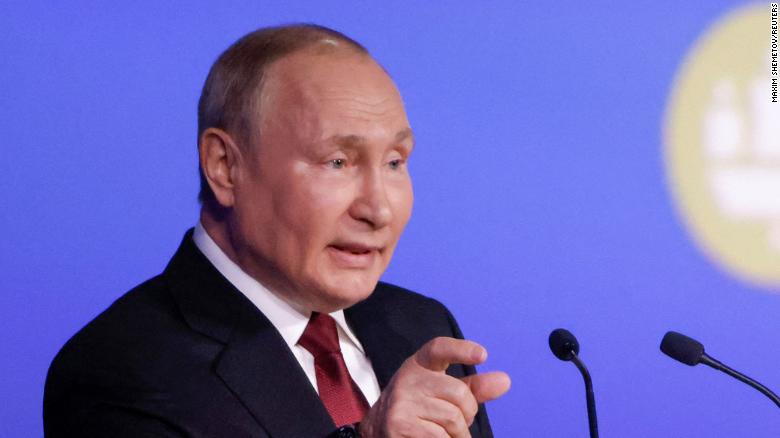
Russia will transfer nuclear-capable Iskander-M missile systems to its ally Belarus over the coming months, Russian President Vladimir Putin said on Saturday.
Putin told Belarusian President Alexander Lukashenko at a meeting in St. Petersburg the missile systems “can use both ballistic and cruise missiles, both in conventional and nuclear versions,” according to the Kremlin.
Russia launched its February 24 invasion in part from Belarusian territory, which borders Ukraine to the north. Throughout the war, Moscow has used Minsk as a satellite base including for many of Russia’s air operations in Ukraine, according to intelligence collected by NATO surveillance planes.
On Saturday, Ukraine claimed Russian forces had fired multiple missiles on the Kyiv, Chernihiv and Sumy regions from Belarus.
In a transcript of the meeting, Lukashenko expressed to Putin his “stress” over what he alleged are flights by United States and NATO planes “training to carry nuclear warheads” close to Belarus’ border.
He asked Putin to consider “a mirrored response” to the flights or to convert Russian fighter jets, which are currently deployed to Belarus, to “carry nuclear warheads.”
Putin replied that “there is no need” to match the US flights and suggested Belarus could modify its own Su-25 aircraft to be nuclear-capable instead.
“This modernization should be carried out at aircraft factories in Russia, but we will agree with you on how to do this. And accordingly, start training the flight crew,” Putin said.
What is the Iskander-M?
The Iskander-M is a Russian-built short-range ballistic missile system that can carry conventional or nuclear warheads with a maximum range of up to 500 kilometers (310 miles), according to Janes Defense.
The weapon uses both optical and inertial guidance systems to strike its targets, hitting them with a range of warheads, such as cluster munitions, vacuum bombs, bunker-busters, and electromagnetic pulse (EMP) warheads, according to the Missile Defense Advocacy Alliance.
The Iskander-M was first used in 2008 during the Russia-Georgia conflict, when the Russian Army used it to hit targets in Gori, according to the Alliance.
CNN has reached out the Pentagon for comment on Lukashenko’s claims.
G7 and NATO summits
The meeting between the Russian and Belarusian strongmen came ahead of a week of summits in Europe, where the grinding war in Ukraine — entering its fifth month — will be front and center.
The leaders of Japan, Canada, the US, the United Kingdom, France, Italy, the European Union and host Germany will meet for the Group of 7 on Monday.
US President Joe Biden hopes to announce new sanctions and military assistance alongside European allies during his visits to Germany and Spain. Both the G7 and NATO summits will hear from Ukrainian President Volodymyr Zelensky, who continues to appeal to the US and other countries for more help.
During his nightly address on Saturday, Zelensky said, “sanctions packages against Russia are not enough” and called on the western partners to provide Ukraine with more “armed assistance.”
“The air defense systems — the modern systems that our partners have — should be not in training areas or storage facilities, but in Ukraine, where they are now needed,” he said.
Meanwhile, Ukraine’s military on Saturday confirmed it had started using an advanced Multiple Launch Rocket System (MLRS) supplied by the US to strike Russian targets. Ukraine’s Commander-in-Chief Valerii Zaluzhnyi posted a video that he said showed the High Mobility Artillery Rocket Systems, or HIMARS, launching its missile at night at an unspecified location.
CNN reported on Thursday that HIMARS had arrived in Ukraine, citing the country’s Defense Ministry.
Fall of Severodonetsk
On Saturday, the eastern Ukrainian city of Severodonetsk was “completely under Russian occupation,” the city’s head of military administration Oleksandr Striuk said, following months of grueling and bloody fighting. Severodonetsk was one of the last major Ukrainian strongholds in the area.
Regional military officials said Friday that the last troops in Severodonetsk had been ordered to leave, as it was impossible to keep defending their positions. This effectively ceded the city to Russia and put the eastern Ukrainian region of Luhansk almost fully under Russian control.
Russia’s Ministry of Defense on Saturday said its forces have now taken control of the entire left-bank of the Siverskyi Donets, the eastern side of the river, and all the borders of the Luhansk People’s Republic.
Lieutenant General Igor Konashenkov, defense ministry spokesperson, said Russian forces have “completely liberated the cities of Severodonetsk and Borivske, the settlements of Voronove and Syrotyne of the Luhansk People’s Republic.”
As reported by CNN
